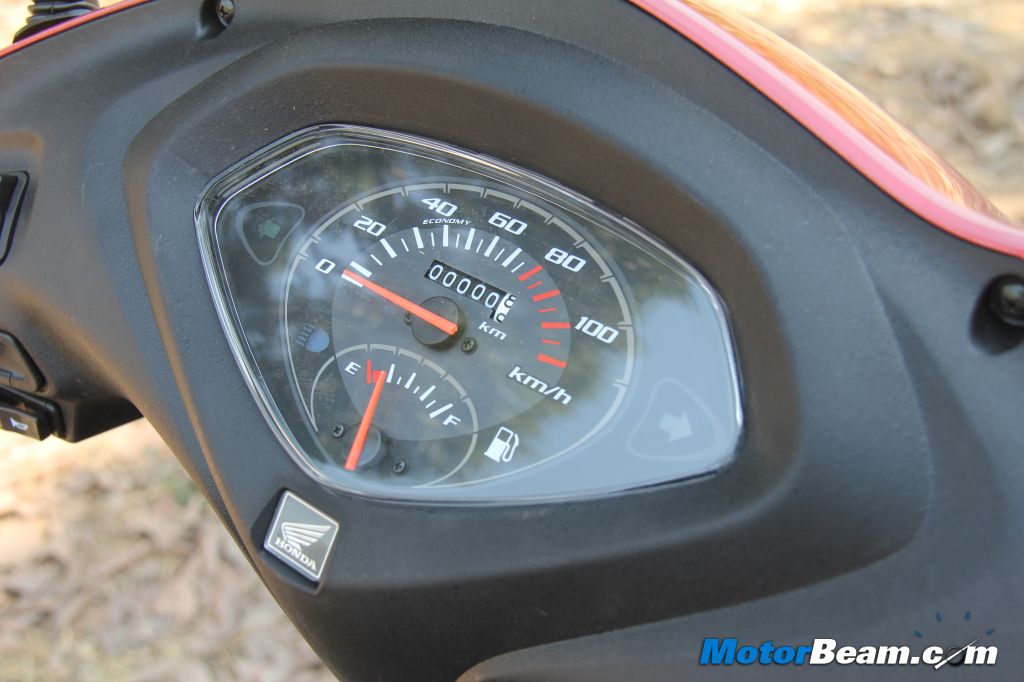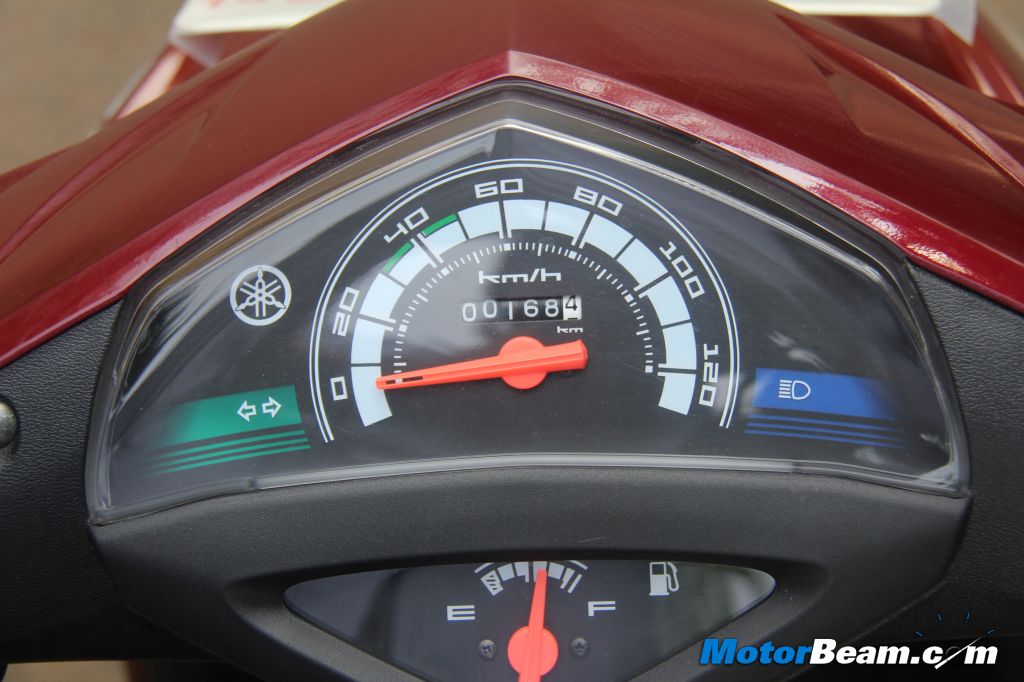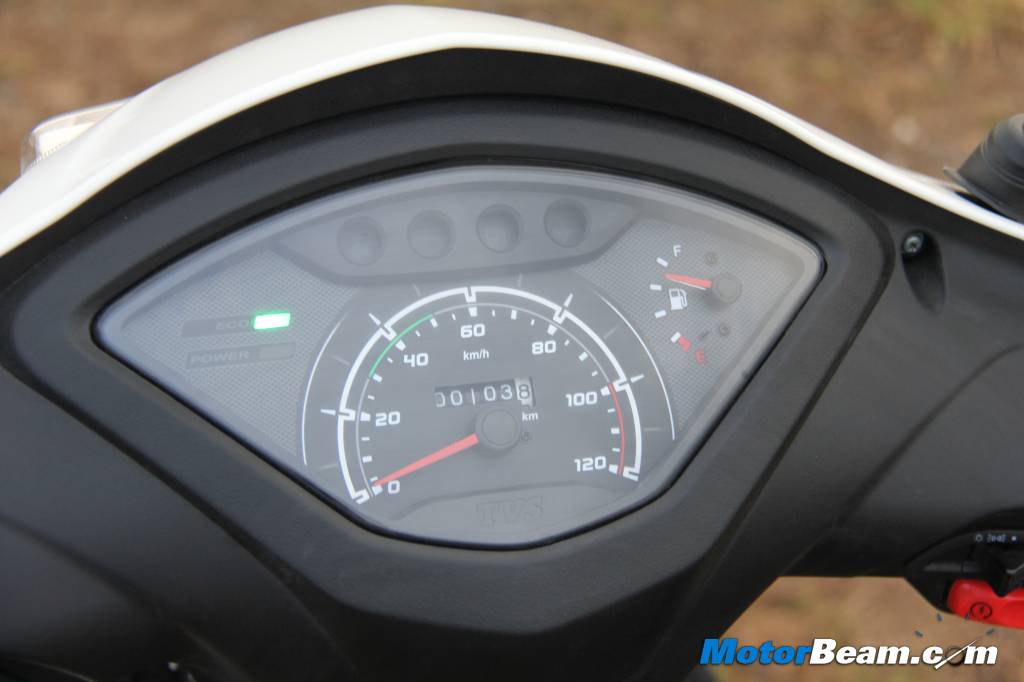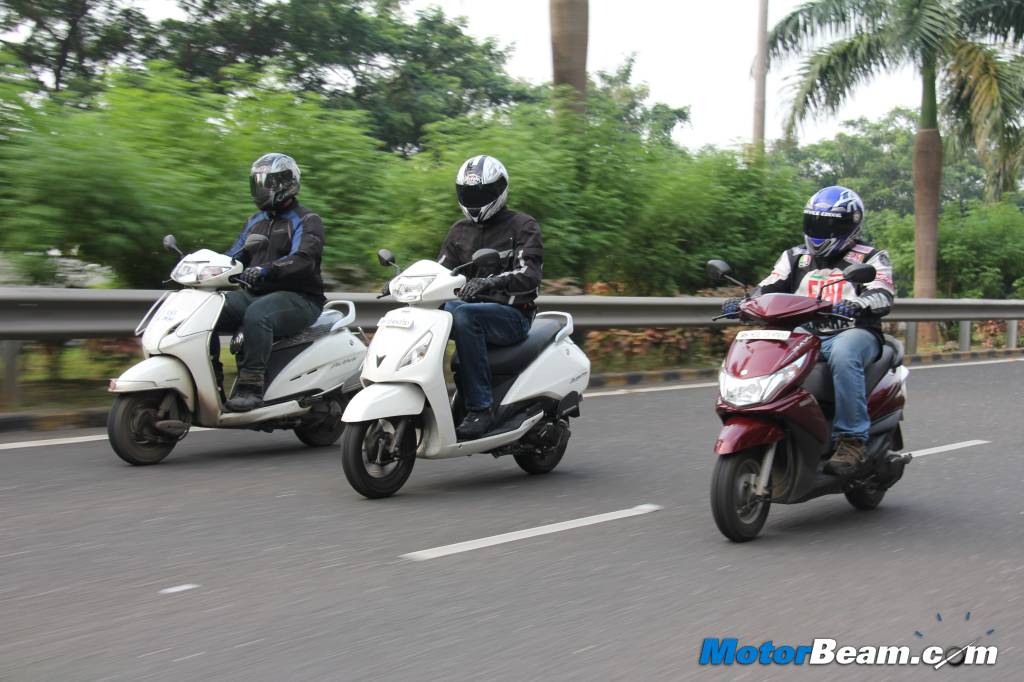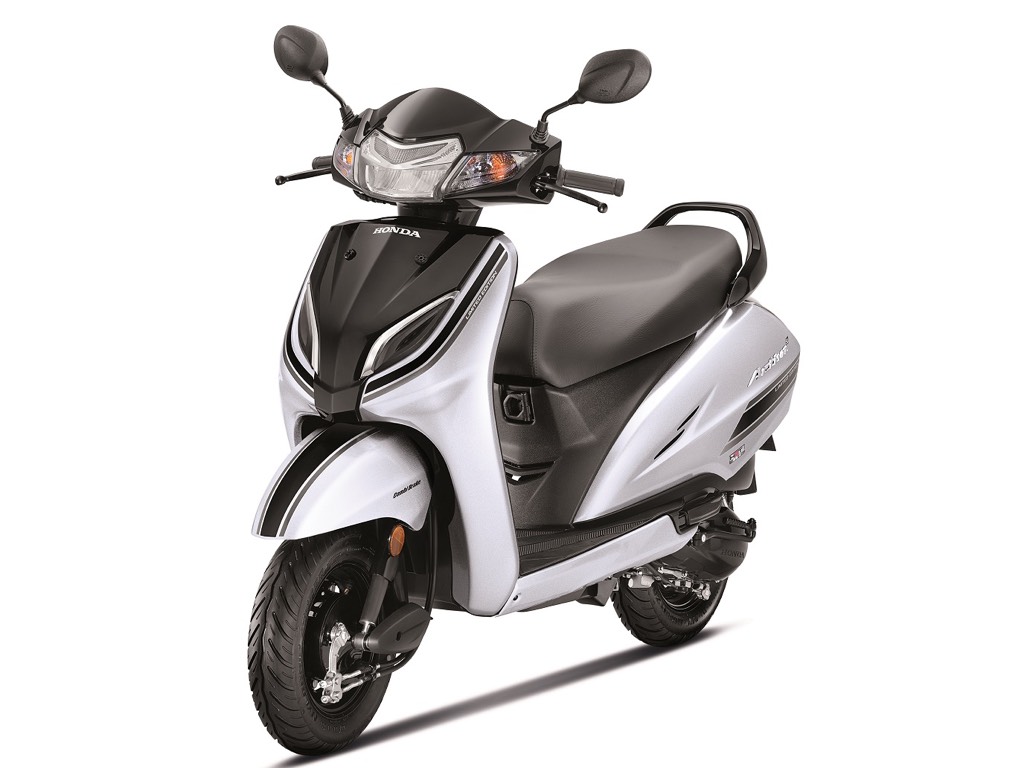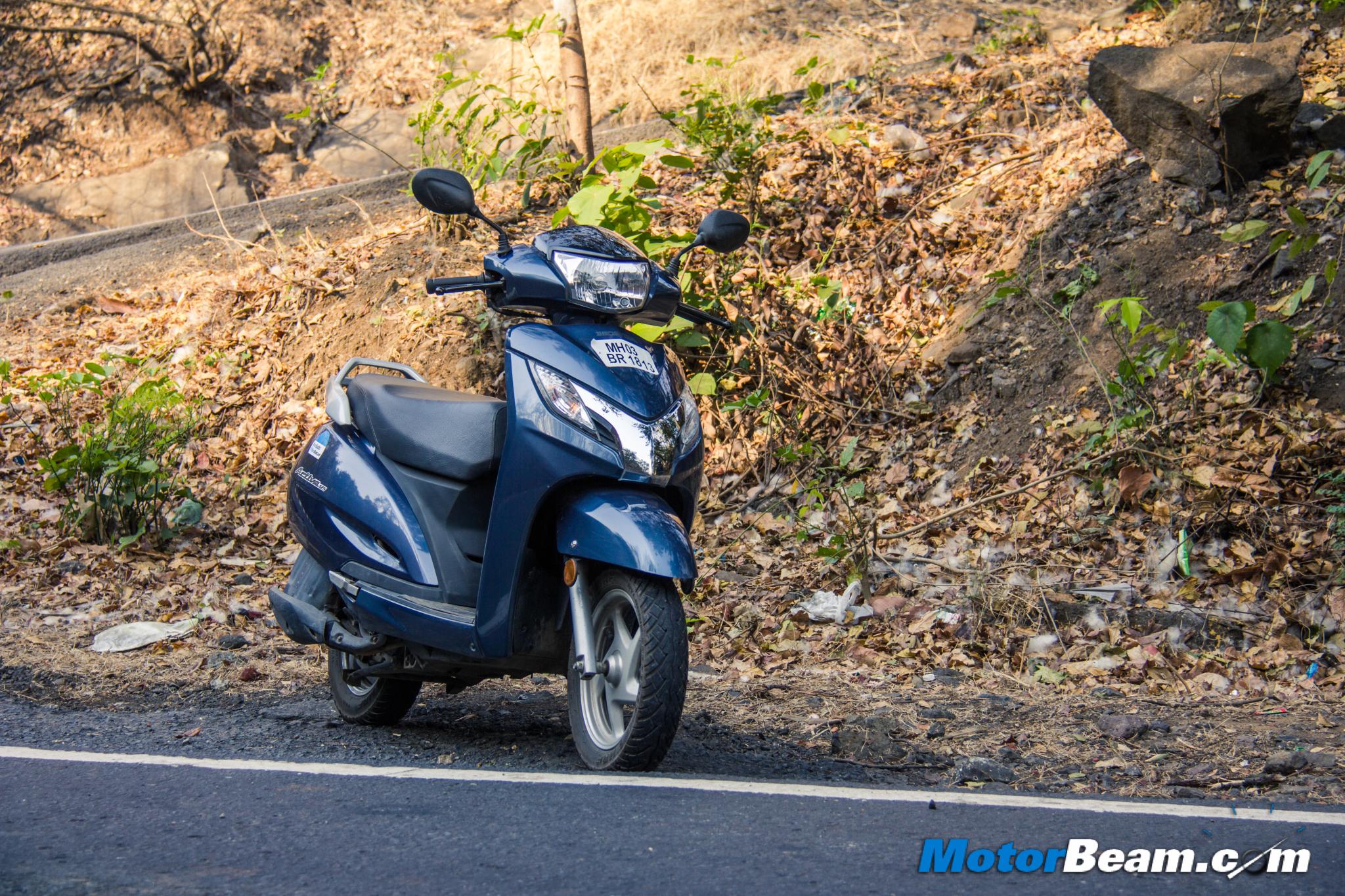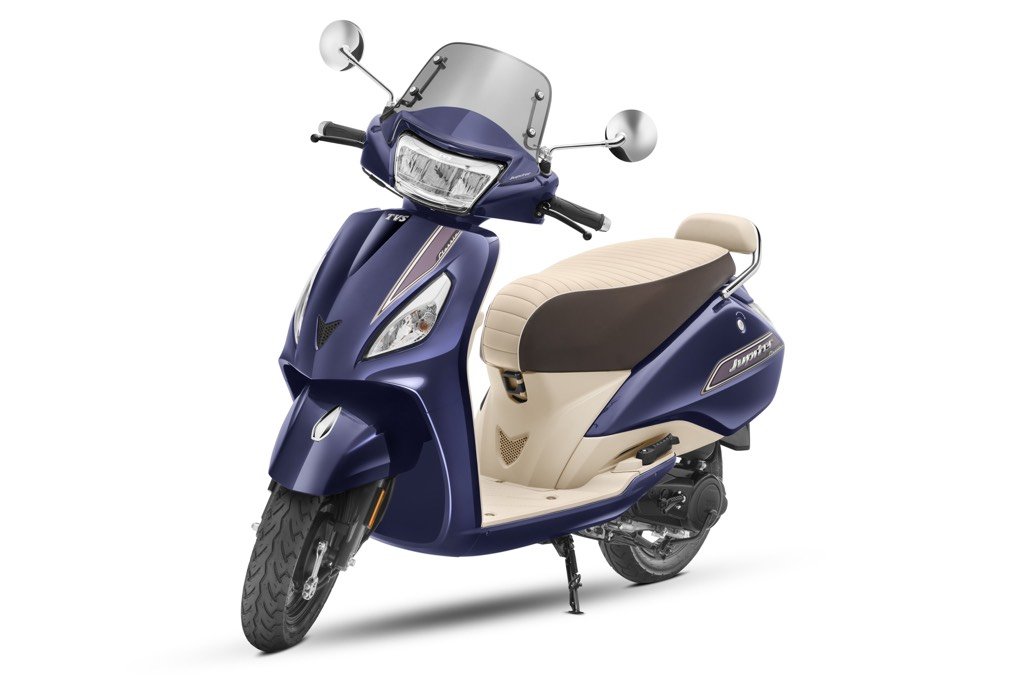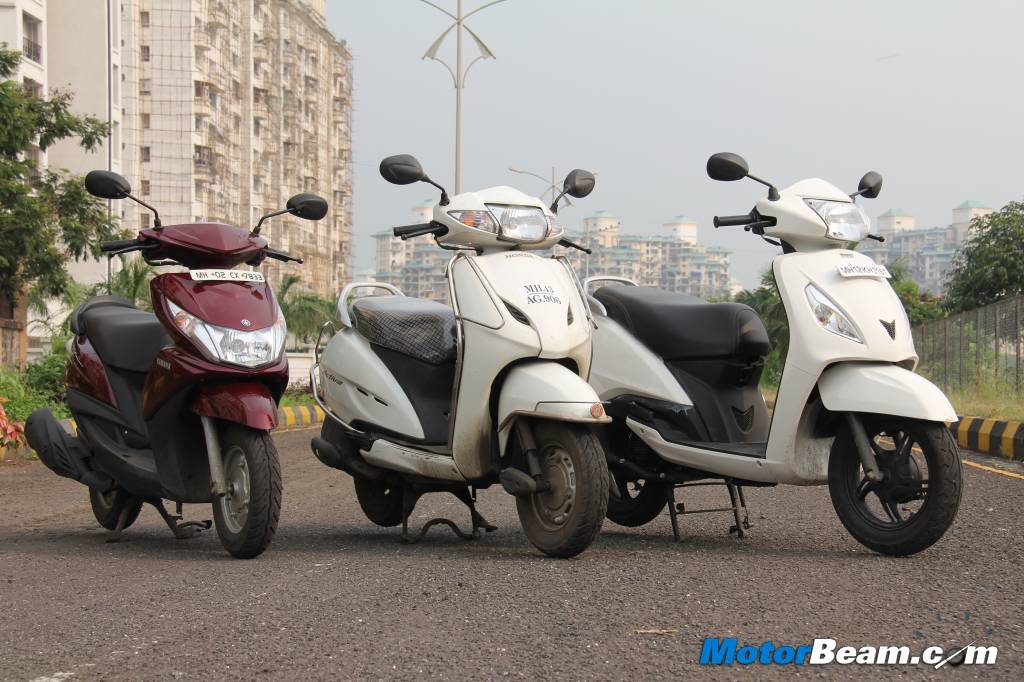
Shootout – TVS Jupiter vs Honda Activa vs Yamaha Ray
Price OTR Mumbai: Rs. 52,200/- (TVS Jupiter), Rs. 57,800/- (Honda Activa), Rs. 53,200 (Yamaha Ray)
The TVS Jupiter makes the Honda Activa look outdated!
You read it first on MotorBeam. Scooters are the most happening thing in the 2-wheeler world. Ever since Honda came up with the Activa, other manufacturers started replying to it but never really took its place or dethroned it. Time goes by and technology comes, which Honda did not use in all areas of the scooters which it upgraded earlier this year. Yamaha, the company which rivals Honda came with a scooter just last year. The Ray no doubt has been the best scooter ever since but then it was not a complete package either. TVS being a domestic manufacturer and one of the leading scooter manufacturers couldn’t sit and watch and hence the new entrant is specifically targeted against the two companies. However, we take the challenge in hand and find out for you, the customer, which is best pick of the lot and which gives you more bang for your buck. Presenting the Honda Activa vs TVS Jupiter vs Yamaha Ray shootout. Let’s fight!
Motor Quest: Honda launched the Activa in India in 2001 while Yamaha made its entry into scooters (with the Ray) only last year. TVS has been an old player and their first scooter, the Scooty was launched way back in 1994.
[flickr size=”center” float=”medium”]http://www.flickr.com/photos/motorbeam/10360696225/[/flickr]
Styling – When it comes to styling, nobody wins without trouble here. The Activa and Jupiter look like siblings with their universal conservative designs. However, there are subtle differences done by TVS. Allow us to explain. The Jupiter comes with a 3D logo on both sides of the panels, which looks like a rounded panel (planet) and Activa comes with sleeker, flowing side panels with twin vents at the front which distinguishes it from the Jupiter. The front headlight section looks the same on the Activa and Jupiter. The difference here is that the Activa gets top mounted turn indicators while the Jupiter gets them on the panel below the headlight. However, it is only at night you will realise that the Jupiter has twin pilot lamps and the Honda does not possess it.
[flickr size=”center” float=”medium”]http://www.flickr.com/photos/motorbeam/10360697894/[/flickr]
When we come to the rear, exactly the same set of tail light units are seen but the one on the Jupiter has an edgy touch to it, while on the Honda, it looks bolder. However, the Jupiter distinguishes itself by an external mounted fuel filter cap with TVS badging and LED inside the stop lamp. The Jupiter comes with alloy wheels which the Honda Activa does not possess, even after being on sale for 12 years! The icing on the cake is the wheels on the Jupiter that are painted matte black, which look great from a distance. However, they are not finished well and turn out to look ordinary when observed closely.
[flickr size=”center” float=”medium”]http://www.flickr.com/photos/motorbeam/10360694055/[/flickr]
The Yamaha Ray with small, low, edgy and compact design is not girly in any single way when it comes to design. Choose the right colour boys and you will be happy with it. The protruding tail light and swooping panels which go upwards gives it a bit of beefiness which somewhat pleases the eye of a scooter buyer who wants strength at first sight on his scooter. The low mounted headlight does not mean it is a copy of the Dio (one factor does not qualify it as a photocopy). Yamaha has also been making scooters internationally since ages. Overall the Ray looks a small ray coming out of the clouds while the other two opponents are fighting to become the sun, aka boss.
Instrument Cluster and Switch Gear – The Honda Activa with side indicators housed inside the meters on both sides with good looking fonts for the speedometer is not exciting, but does the job rather well. Switchgear on the Activa is good with the feel and clicks being positive. The Ray has the most funky cluster of the lot with toy like speedometer needle and rest of indicators such as high beam, solitary indicator give the digital feel and modern aura. Fonts used on the Ray’s cluster are quite bold and gel along with the overall theme quite well. The fuel gauge pod is separately housed below the cluster with the same toy-ish needle. Switchgear on the Ray is top quality with precise click and solid feel.
The TVS Jupiter‘s cluster is loaded to the gills and comes with a black background, which looks sporty. However, the fonts are a bit of a let down. The Jupiter comes with fuel reserve light indicator, eco and power mode and turn indicators on both sides. Switchgear on the Jupiter is good with positive click and feel. The high beam button is also the pass button, which is a very slick job indeed. The special thing about the Jupiter’s switchgear is the yellow coloured switch for the horn and red colour for the ignition, something we haven’t seen on any other scooter until now, except the Wego.
[flickr size=”center” float=”medium”]http://www.flickr.com/photos/motorbeam/10360879253/[/flickr]
Ergonomics – Ergonomics on all these scooters is almost the same. The rider sits upright while the handlebars are positioned slightly lower in the Ray and Jupiter. The Activa is more upright biased. The Ray, Activa and Jupiter all have a comfortable riding stance with a mighty comfortable seat for city roundabouts and for intercity highway stints. The most comfortable of the lot with excellent seat cushioning is the Jupiter, it truly feels like a sofa when it comes to padding. The Activa and Ray too have mature seat cushioning but for intercity long runs, the Jupiter just seems to be slightly ahead. The Ray with its low seat height is a boon for short and tall riders alike, which is surprisingly brilliant. The rear view mirrors are well positioned on these scooters and pillion comfort on the Activa and Jupiter is better than the Ray by a small margin.
[flickr size=”center” float=”medium”]http://www.flickr.com/photos/motorbeam/10360700145/[/flickr]
Practicality – Offering the highest leg space in the segment is the Jupiter and Activa while the Ray with its tiny dimensions comes last. When it comes to under seat storage, the Activa trumps the Jupiter by offering 18-litres of under seat storage while the Jupiter offers 17-litres. The TVS Jupiter comes with two hooks for carrying bags on the leg board. One at the bottom exactly like the Suzuki Swish, which does not help carry longer bags or edible stuff. However, the one on the top is retractable and will end up doing most of your job. The Yamaha Ray offers a similar hook at the top, which seems to be the clever option currently in all new scooters. The Honda Activa continues with just one hook mounted below the seat, but a job well done when it comes to mounting it right. The unit is a metal hook unlike the Jupiter, which has a plastic one, hence the comparison with the Swish. None of these under seat storage compartments can fit a full faced helmet, smaller or half face fit well in the Jupiter and Activa and even after that they provide decent storage space for more. The Ray has the least under seat storage (15.5-liters) and can carry only tit bits.
[flickr size=”center” float=”medium”]http://www.flickr.com/photos/motorbeam/10360877793/[/flickr]
Performance and Gearbox – Different engines power these scooters with capacity varying by a small margin. However, the king of displacement is the Yamaha Ray with the 113cc motor producing 7.1 PS of power at 7500 RPM and 8.1 Nm of torque at 5500 RPM. The Honda Activa is powered by a 109cc engine producing 8.08 PS of power at 7500 RPM and 8.74 Nm of torque at 5500 RPM. The TVS Jupiter is powered by 110cc engine that belts out 8 PS of power at 7500 RPM and 8 Nm of torque at 5500 RPM. What did we learn here? All the scooters produce different amount of power and torque at exactly the same RPM. However, the performance on road is very different. Performance depends on how the transmission behaves and how the engine is tuned and the important factor is the weight of these machines. The Jupiter tips the scale at 108 kgs while the Activa weighs 110 kgs and the scooter on a diet is the Yamaha Ray with a weight of 104 kgs.
Like we said in our first ride report, the engine of the TVS Jupiter is not as energetic as the Wego’s and after testing the scooter thoroughly we stand by it, again. The engine on the Ray offers good performance and the Activa has been the boring of the lot before HET came and dropped a wee bit of fun with crisp throttle response. The Jupiter yet again wins, why? After all, the Jupiter’s engine is derived from the Wego and it has not completely lost the throaty nature and crisp throttle response. Overall, all these engines offer linear performance, nothing to rejoice.
[flickr size=”center” float=”medium”]http://www.flickr.com/photos/motorbeam/10360698365/[/flickr]
On the road then, performance competition is between the TVS Jupiter and the Yamaha Ray. Both these scooters are extremely quick of the line and have stupendous low and mid-range pulling power. However, the Activa just keeps watching them when it comes to a standing start despite the numbers being in the same ballpark. First thing first, the Activa is 2 kgs heavier than the Jupiter and a massive 6 kgs heavier than the Ray. Then we come to the transmission, which on the Activa is tuned for pulling hard after 50 km/hr, which translates into only mid-range power. Transmission on the Jupiter is very seamless, there is no lag or jerks and it just pulls effortlessly making it the best transmission in the 110cc scooter segment by far and thus posing a faster time from 0-60 km/hr too.
[flickr size=”center” float=”medium”]http://www.flickr.com/photos/motorbeam/10360689694/[/flickr]
Coming to top speed, the Jupiter and Activa do reach 85 km/hr on the speedo while the super optimistic meter on the Ray shows it is doing 100+ km/hr. GPS results show that the Ray was doing 80 km/hr. All this translates into these scooter having roughly the same top speeds. However, to the junta out there who need low and mid-end power, the Jupiter and Ray are equally matched because they always have power on tap when pottering in city traffic while the Activa loses because it takes a wee bit of time to build up momentum, not a deal breaker though. The Ray is the most fuel efficient of the lot offering 45.4 km/l in the city. The Activa returns 44 km/l while the Jupiter despite riding hard and fast all day long with speeds in the range of 60 – 70 km/hr, managed to return 44.4 km/l. We are talking about the Jupiter which has not seen first service yet and has done its first 200 kms with us, expectation of increase in mileage is imminent.
[flickr size=”center” float=”medium”]http://www.flickr.com/photos/motorbeam/10360688385/[/flickr]
Riding Dynamics – If a Yamaha comes into a comparison, do we need a verdict on who wins the dynamic round? The Ray is just mesmerising when it comes to dynamics. Armed with the grippiest tyres of the lot and firmly tuned telescopic suspension at the front, you are in for a treat on the Ray. The perfectly synced rear with the lowest kerb of 104 kgs in the entire scooter segment, it is the recipe for pure riding nirvana when it comes to scooters. Brakes on the Ray are the best in the entire segment. Perfect feedback and feel from the drum brakes makes you feel that drums are not outdated. The Jupiter then, does not let the Ray easily reach the finish line of a twisty track without stiff competition. 12-inch wheels, telescopic suspension, gas charged suspension and what TVS calls body balance, helps the Jupiter ride like a more mature scooter then it is. Brakes are good on the Jupiter as well but the Activa’s combi-braking system (CBS) offers the most confidence to the rider.
[flickr size=”center” float=”medium”]http://www.flickr.com/photos/motorbeam/10360690144/[/flickr]
However, it is the TVS made tyres on the Jupiter that absolutely play spoilsport. They screech whenever you brake hard and do not offer a confidence-inspiring ride. The front of the Ray and Jupiter offer quick direction change and feel agile and nimble making riding a pleasurable experience with excellent feedback which makes high speed direction changing less nervous then the Activa. The Activa then, bolted with trail link suspension at the front and conventional spring suspension at the rear makes it feel outdated. There is a skittish feel from the front and the scooter behaves the worst on bad roads. The Activa does not feel in sync while riding hard despite it having stiffer suspension. It is simply no where near fun to ride as the competition.
[flickr size=”center” float=”medium”]http://www.flickr.com/photos/motorbeam/10360693726/[/flickr]
Coming to the most important part, ride quality of these scooters. The Ray handles beautifully but has a downside and that is the stiff ride quality, which gets better when you start going faster but is not exactly what we call plush at low speeds. The Activa has a better ride quality than the Ray, however, it could have been better though because of the shortcomings in the dynamics department. The Jupiter is here, changing everything. The Jupiter with 12-inch wheels offers superior ride quality and ride stays the same if you are going faster on bumpier, broken roads too. Low speed ride quality is excellent but not plush, let’s say like a Vespa.
[flickr size=”center” float=”medium”]http://www.flickr.com/photos/motorbeam/10360888443/[/flickr]
Verdict – All these scooter are positioned differently but which is the best of the trio? The Honda Activa has a lot of shortcomings, being the priciest of the the three, it doesn’t offer much and feels outdated in front of the others, putting it last in this test. The Yamaha Ray comes in second and although a very potent scooter, it lacks in terms of practicality. The TVS Jupiter easily emerges on top. It comes with more features, better ride quality and fresher styling. Not to forget, it is as practical as the Activa with same km/l and km/hr numbers being offered by its tried and trusted engine. The Jupiter is a no brainer of choice and the most sensible option in our market today. If you have TVS dealer and service centre in your locality, go ahead and buy this planet scooter.
The TVS Jupiter is the best package in the 110cc scooter segment today, which helps it easily beat the Honda Activa to emerge as the new king of the segment.
[flickr size=”center” float=”medium”]http://www.flickr.com/photos/motorbeam/10360695946/[/flickr]
Further Reading –
TVS Jupiter Review
Yamaha Ray Review
Honda Activa HET Review


